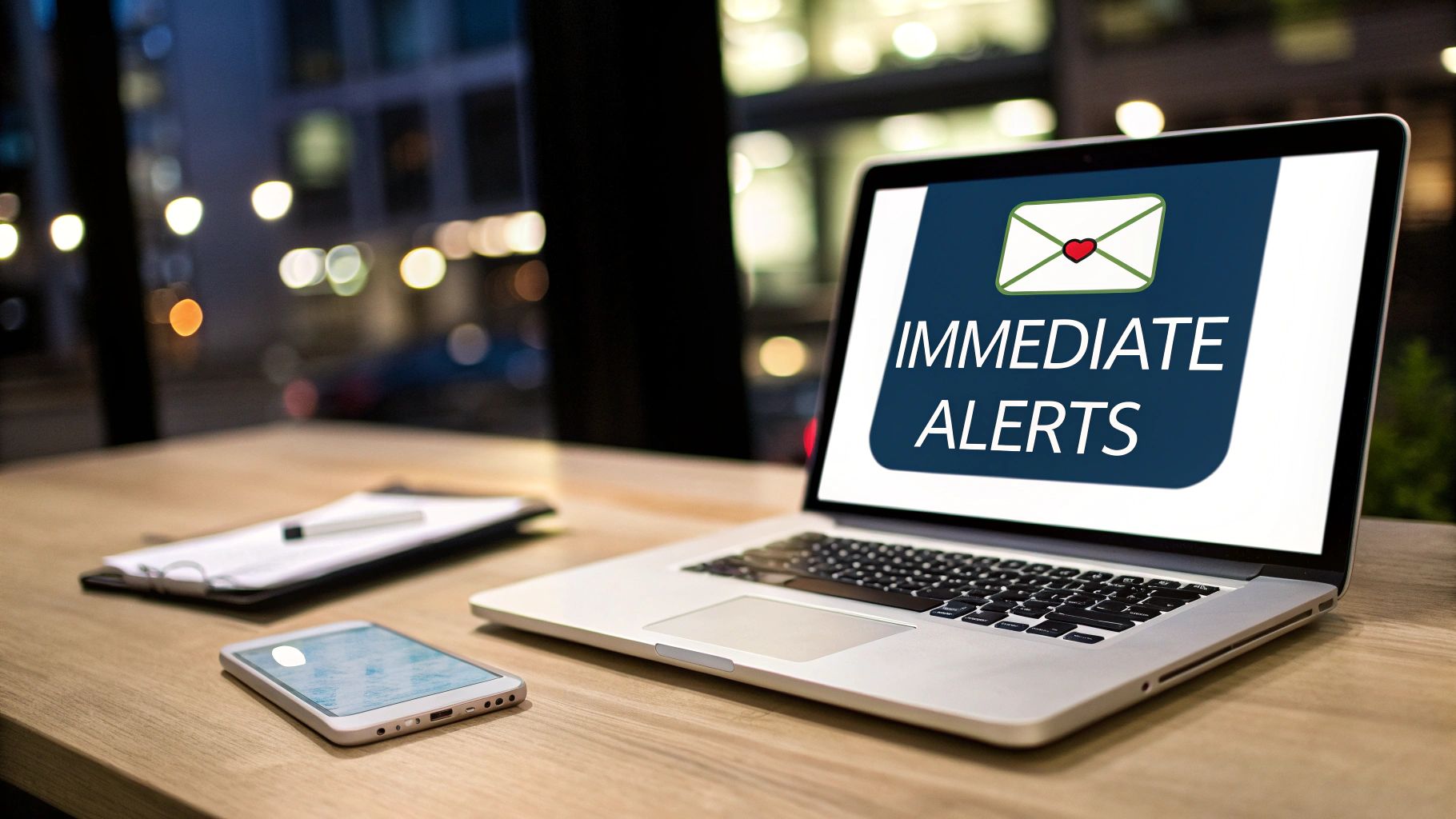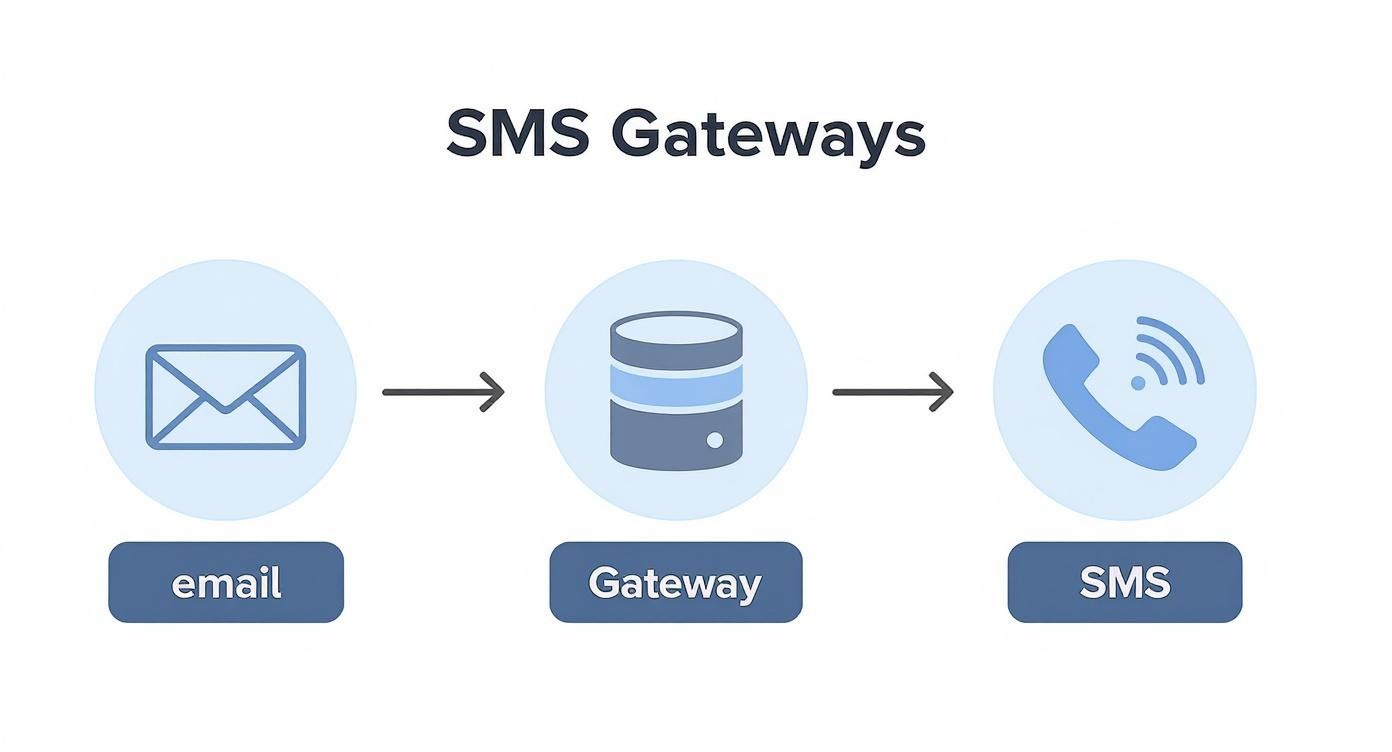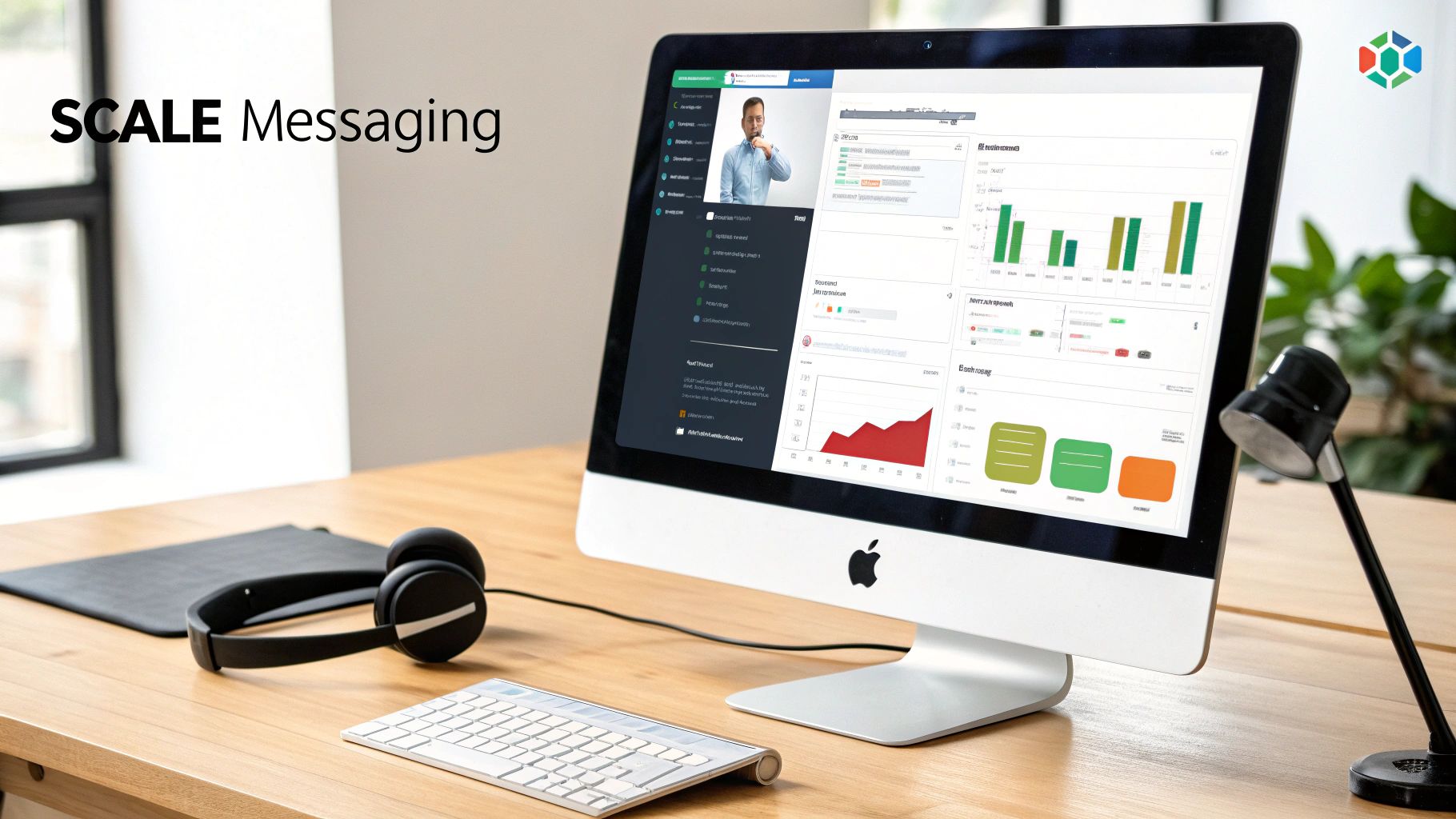Sending an email via SMS might sound a bit old-school, but it's surprisingly simple. It all boils down to using a special SMS gateway address. Think of it as a unique email address for a phone number, made by combining the number with its mobile carrier's domain. Your email client treats it like any other email, but the network translates it into a standard text message on the other end.

In a world buzzing with messaging apps, you might wonder why this method still matters. Well, it's a powerful and direct way to communicate that cleverly bridges two different technologies. It’s not just a neat trick; it's a strategic tool that offers a reliable channel when others might fail.
Imagine you're a system administrator responsible for keeping servers online. If the office internet goes down, all those automated email alerts are suddenly useless. But if those alerts are sent via SMS, the message gets through instantly, internet or not. That's a lifesaver.
Or think about a small local salon. They can automate appointment reminders by sending an email directly to a customer's SMS gateway. That text message is far more likely to be seen than an email buried in a crowded inbox, which is a simple way to drastically cut down on no-shows.
For businesses, this direct line is invaluable. It’s about meeting customers where they are most responsive—on their phones. This simple tech ensures important messages are seen immediately.
To give you a better idea, here are a few scenarios where this approach really shines.
These are just a few examples, but they highlight the core advantage: reliability and immediacy.
This synergy taps right into the instant nature of texting. Research has shown that businesses combining SMS and email campaigns see a staggering 429% higher conversion rate than those using email alone. It makes sense when you consider that most text messages are read within five minutes of being received.
While this method is powerful, it's also worth exploring other alternatives to email to build a well-rounded communication strategy.
This capability is especially useful for:
Before you start sending emails to text message inboxes, it’s worth pulling back the curtain to see what’s making it all happen. The whole system relies on a surprisingly simple and old-school piece of tech called an SMS gateway.
Think of a gateway as a digital translator or a bridge. On one side, you have the world of email—like your Gmail or Outlook account. On the other, you have the mobile carrier networks—AT&T, Verizon, T-Mobile, and so on. The gateway is the go-between that connects these two very different worlds.
When you fire off an email to a special phone number-based address, the gateway catches it, strips out all the email fluff (like signatures and formatting), and boils it down to a plain-text message that a phone can understand. It’s an elegant solution that cleverly uses the infrastructure already in place.
The real trick is in how you address the email. Instead of a typical jane.doe@email.com, you’ll use a unique format that combines the person's phone number with their mobile carrier’s specific gateway address.
For a Verizon customer, it might look like this: 5551234567@vtext.com.
When Verizon's server sees an email come through to its @vtext.com domain, it knows exactly what to do. It reads the first part of the address, finds the phone number 555-123-4567 on its network, and forwards the body of the email as a standard text message. Every carrier has its own gateway, which is why knowing the recipient’s provider is a must for this to work.
This isn't some brand-new invention. Email-to-SMS technology is a time-tested workhorse that's been around for decades. It's proven to be a super reliable backup for communication when apps or data networks fail.
This concept was a huge leap in mobile communication back in the early 2000s, letting people send and receive emails on their phones long before smartphones were a thing. If you're curious about the history, you can dive deeper into the evolution of SMS marketing on notifyre.com.
Understanding this simple translation process makes it much easier to troubleshoot if something goes wrong. Whether you're sending a quick note to a friend or a critical alert for your business, you now know the "magic" is just a clever bit of digital translation.
To send an email that lands as a text message, the first thing you absolutely need to know is the recipient’s mobile carrier. This isn’t just a small detail; it's the key to the whole process. Without it, you won't know which gateway address to use.
The most straightforward way to get this info? Just ask.
If that's not an option, you could try a free online carrier lookup tool. Be warned, though—these aren't always 100% accurate, especially if someone recently ported their number to a new provider.
Once you have the carrier name, you can build the special email address. The format is pretty simple: the person's 10-digit phone number (no dashes or spaces) followed by the "@" symbol and the carrier's gateway domain. For example, if you're texting someone on AT&T with the number 555-123-4567, the address would be 5551234567@txt.att.net.
This infographic breaks down how your email makes its journey to the recipient's phone.

As you can see, the carrier's gateway acts like a translator. It takes your email, strips it down to its text-based core, and forwards it as a standard SMS.
Every mobile provider has its own unique domain for both SMS (text-only) and MMS (multimedia) messages. If you use the wrong one, your message will either bounce back or simply vanish.
A quick pro-tip: SMS gateways are strictly for plain text. If you want to send an image, a GIF, or a longer message, you'll need to use the carrier's MMS gateway address instead. These are often different domains, so double-check.
To make things easier, I've put together a table with the gateway addresses for the major US carriers.
Here is a quick reference list of the correct email-to-SMS and email-to-MMS gateway domains for the most popular mobile service providers. Just find the carrier, grab the right domain, and you're good to go.
This isn't an exhaustive list, but it covers the big players. A quick search online for smaller carriers will usually turn up the right address if you need it.
With the correct gateway address ready, just pop open your usual email client, whether it's Gmail, Outlook, or something else.
Start a new email and paste the full gateway address into the "To:" field.
Keep your subject line short and sweet. On many phones, the subject line shows up first, almost like a title for your text.
Then, write your message in the email body. Remember the golden rule of SMS: keep it under the 160-character limit. Anything longer might get awkwardly split into multiple texts or cut off entirely. For that reason, it's a good idea to remove your email signature or any other boilerplate text.
Once your message is ready, just hit send. Your email will be on its way to their text message inbox.
The manual gateway method is fantastic for a one-off text or a quick personal update. Let's be honest, though—when your business needs to communicate at scale, hunting down carrier gateways for every single customer is a massive operational headache. It’s just not sustainable.
This is where dedicated business communication platforms come into play.
These services are built to handle all the messy, behind-the-scenes work of email-to-SMS communication for you. Instead of guessing if a customer is on AT&T or Verizon, you just use the platform's dashboard or API to send your messages. They manage the entire backend process, making sure your messages get formatted correctly and delivered to the right mobile network, every single time. For any business serious about using SMS, this approach is non-negotiable.
The real magic of these platforms isn’t just sending messages; it’s everything else they can do. They’re packed with features designed specifically for business needs, blowing manual methods out of the water.
You get tools that actually help you grow:
A great example of this in action is a service like My AI Front Desk, which uses this kind of technology to power its 24/7 virtual receptionist.

This platform shows how automated systems can instantly fire off SMS appointment confirmations and follow-ups after a call. The result is a seamless and professional customer experience without anyone lifting a finger.
Key Takeaway: For business use, switching from manual gateways to a dedicated platform isn't just about convenience—it's a strategic move. It's how you scale your communication, gather meaningful data, and genuinely improve customer interactions.
By offloading the technical heavy lifting to a specialized service, you free yourself up to focus on what really matters: crafting messages that connect with your audience, not worrying about the delivery mechanics. This shift empowers your business to use SMS as a truly powerful channel for growth.
Knowing how to send an email via SMS is a neat trick, but doing it effectively is what really matters. A few common snags can easily derail your messages. Fortunately, with a bit of foresight, you can sidestep them and make sure your communications land perfectly every time.
One of the biggest hurdles is the character limit. A standard SMS message maxes out at 160 characters. If your email body—including any hidden formatting or signatures—goes over this limit, the carrier might chop it into multiple texts. Even worse, it could just cut it off, leaving your recipient with half a message.
To avoid these problems, get in the habit of stripping out complex formatting before you hit send. This means no HTML, rich text, or those fancy email signatures. Just think of it as a simple, plain-text memo. This not only keeps you under the character limit but also makes your message much easier to read on a small screen.
You also need to be mindful of what you're sending. A simple text-only message will fly through an SMS gateway without a problem. But if you include an image or an attachment, it needs to go through an MMS gateway, which uses a completely different address. Send it to the wrong one, and it's a guaranteed delivery failure.
The most important rule, especially for businesses, is getting explicit consent before you start messaging people. Unsolicited texts aren't just annoying; they can violate regulations and do permanent damage to your brand's reputation.
To make sure your messages are not just delivered but also well-received, it pays to understand the general principles of business communication best practices. These ideas go beyond just texting and help you build real trust with your audience.
Here are a few final tips from the trenches:
Once you get the hang of sending emails to a phone as a text message, a few questions usually come up. Let's clear the air on some of the most common ones so you can use this method with confidence.
First up, a lot of people wonder about the cost. For the person sending the email, it’s usually free—just another email out of your inbox. The catch is on the receiving end. The recipient's mobile carrier treats it like any other SMS message. If they don't have an unlimited texting plan, standard message rates will apply.
Taking this method global is possible, but it gets a bit messy. You need to know the recipient’s international carrier and then hunt down its specific SMS gateway address. This can be surprisingly difficult to find, which is why dedicated third-party SMS platforms are often the smarter move for international messaging. They handle all that complexity for you.
Security is another big one. An email sent to SMS isn't secure—it's not end-to-end encrypted. It travels through email servers and carrier networks in plain text, making it vulnerable.
Important Takeaway: Think of this method like sending a digital postcard, not a sealed letter. It’s perfect for general notifications, simple alerts, and non-confidential updates. You should absolutely avoid sending sensitive information like passwords, credit card numbers, or social security details this way.
Ready to streamline your business communications with automated SMS and calling? My AI Front Desk offers a powerful AI receptionist that can handle appointment scheduling, send confirmations, and engage leads 24/7. Discover how our platform can save you time and convert more customers by visiting https://myaifrontdesk.com.
Start your free trial for My AI Front Desk today, it takes minutes to setup!








